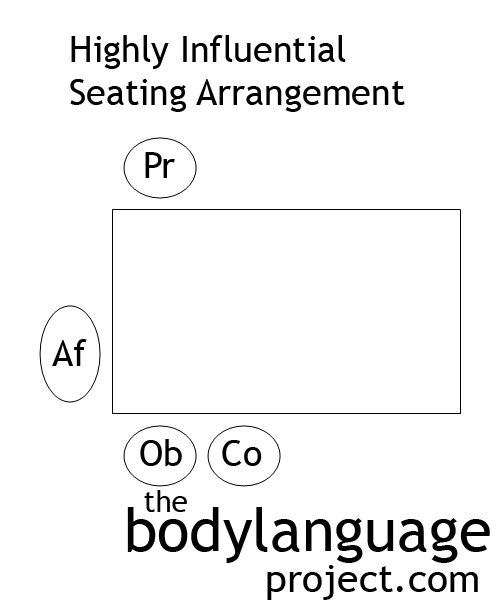There will be times when we’ll need to tell people that we are there for them, but at the same time, not overstep their boundaries. One of those times is when we act as salespeople where we want to appear helpful but not overly friendly. When dealing with the public especially in retail, we need to adopt a different style of body language than we would with close friends.
When we sell, we need to convey “I’m here to help” so we should convey alertness and motivation, but the message isn’t “I’m your friend” and we should maybe go for a drink sometime to catch up. We’ve all seen good sales people who meet you with a smile, but what is an effective smile in a retail scenario? If we smile too big, we come across as too friendly which can turn some people off. Instead we should perform a slight smile with brief eye contact. This shows them that we’ve noticed them, and are willing and able to engage any questions or need for assistance they might have. Eye contact should be non-threatening and non-challenging. Eye contact combined with our anchoring smile tells the consumer that we are employees, and that we are there to serve them. Your body should show that you are confident and assertive primarily to serve the company you work for, as you have agreed to a certain level of responsibility.
The next step is to identify the type of client you are working for. Some clients prefer to look around on their own and not be bothered and others want and even need to be directed. Others yet, will prefer a mixture of the two, especially after they have identified a product of interest. We know someone is comfortable shopping by themselves because they use sentences such as “Just browsing” or “Having a look around”. Someone that wants more direct help will immediately find a clerk and ask lots of questions and express their needs and general interests. If they don’t find what they want immediately, they will hang around a clerk, or leave altogether if they don’t get the service they require.
Clients that are short and hurried with their verbal language, who make very little or no small talk and speak only of the products of interest, only want to get their items and leave. They won’t want to interact on a personal level or chat about the weather or other such affairs. This is a fine stance in a customer and should be respected. These types of people won’t even see you as a being human, rather, they will see you as a means to their end. We identify these people because they seem to look ‘through’ or over you and seem extremely focused on the product. They will give no rapport signals and very little facial expressions. As a salesperson you should hold a neutral body position and stay relatively expressions and avoid trying to engage them on other levels besides that which directly involves the sale. In other words, sell the product and it’s features rather than yourself. Push them through the product selection quickly, talk about their pro’s and con’s and check them out as efficiently as possible, and you will make them happy.
“Friendly” clients will want something wholly different. They will begin to chat with you, express eye contact and might even touch to establish more rapport. Often the conversation will start off on an item then move onto something much less centered, it could evolve into family, sports or events. For these clients, the relationship is very important so with these types of client mirror their body language and use plenty of eye contact in effort to make them feel comfortable and as if they are speaking to a friend. This type of client is seeking to buy the entire experience including the salesperson and will often buy just because they liked the salesperson. This client requires the salesperson to sell “themselves” as part of the package.
A third type of client is the “follower.” He or she will want the salesperson to take charge. This client is usually unfamiliar with the buying process, or they are unsure of what they are looking for. These types of people stand out to us especially in situations like airports because it is such a confusing affair. They will ask specific questions but these questions might be inappropriate because he or she is not totally familiar with the subject matter. This client will show submissive body language as they try to protect themselves from embarrassment and show willingness to follow someone in charge. Followers will show timidity and nervousness at times, and take up less space than normal. Sometimes confident clients appear to be followers, but they only appear so because they are in a novel environment, or are beginning to shop for an item they don’t have much knowledgeable about. Confident people won’t show such submissive gesture at all, but will otherwise show a desire to follow the salesperson by their verbal language. Confident, ill-informed buyers will still tend to closely hang onto the salesperson like a “follower”, not because they require hand-holding, but rather because they wish to be sold directly and will purchase if enough information is provided.
The final type of client is the “dominator.” They will immediately stare you down and make strong eye contact. They will be suspicious of the salespersons motives and want to maintain control because they fear being taken advantage of. The dominator’s voice will be firm with neutral or negative facial expressions. This client might move into the salespersons personal space and try to intimidate them or they may intrude over a counter or place a bag or coat on it. They may be grabby and use touch to influence the salesperson. In this situation, the salesperson should remain neutral or positive and not mirror the client’s body language or conflict may escalate. Negative body language such as this is usual for someone with a specific complaint. Instead of fighting their language stay pleasant and hear them out trying to show empathy for their situation even if you aren’t actually able to do anything about it. At times, dropping dominant signals can help, slumping the head and shoulders shows that we are willing to submit to them. Sometimes winning the battle includes feigning loss and conceding to their demands.


